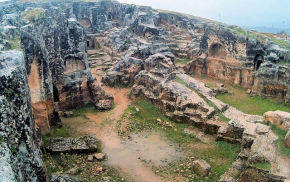 The ancient city of Perre (or Perrhe), one of the five largest provinces of the Kingdom of Commagene (163 BC-72 AD), known as Me'arath Gazze Pörön in ancient sources, and Pirin and Perin in Mesopotamia, is located in Adiyaman province today. The city was on the road from ancient Melitene (today's Malatya) to the capital Samosata (today's Samsat), hence it had a geopolitical importance in the past due to its location on the connecting road route.
The ancient city of Perre (or Perrhe), one of the five largest provinces of the Kingdom of Commagene (163 BC-72 AD), known as Me'arath Gazze Pörön in ancient sources, and Pirin and Perin in Mesopotamia, is located in Adiyaman province today. The city was on the road from ancient Melitene (today's Malatya) to the capital Samosata (today's Samsat), hence it had a geopolitical importance in the past due to its location on the connecting road route.
During the Roman period the city provided financial support to the construction of the Septimius Severus bridge (known as Cendere bridge today) in 198-200 AD. The beauty of its water is mentioned in ancient Roman sources, and it is told that it was used as a resting place by caravans, passengers and armies. The Roman Fountain, where the said water flows, is still in use today.
Turned into an episcopal center and known as the Holy City during the Byzantine period, Perre sent its archbishops to the ecumenic council convened in Nicaea (today's Iznik) in 325 AD and in Chalkedon (today's Kadiköy in Istanbul) in 451 AD as a city of the Persidas province under the rule of bishop Ioannes Perdos. The fact that Andreas of Samosata mentioned some important bishops in Perre in the letter he wrote in 433 AD shows that the city was also an important city in terms of religion. All these show us that Perre was a city of both religious and geopolitical importance in the Antiquity.
According to the work Synecdemus of geographer Hierocles, in the 6th century AD Perrhe was a city of the Province of Euphrates of the Byzantine Empire. In the 7th century AD the city was subject to the Arab invasions like the other settlements of the region. Perre lost its importance after the Byzantine era and could not catch up with its former bright period. On the original settlement part of the ancient city there is also a late period settlement.
The excavations, which started in 2001 and continued at intervals, are being carried out by the Archeology Department of Adiyaman University. In recent excavations they unearthed important artifacts such as residential areas, cisterns, and mosaics. The section called as the "ladder of infinity" is also interesting. The large mosaic, which is 155 square meters (1668 square feet) in size, is the largest mosaic pavement in Adiyaman that has emerged as a single piece. On the mosaic, in the middle scene, there are wild goats and chickens grazing in the vine branches. Meanwhile, to the left and right of the center stage there is a depiction of a duck and a pigeon with a red ribbon around its neck. It is dated to the 5th century AD.
Besides these, a small part of the city walls, cistern, grape press halls, stone quarry, weaving workshop, fountain, and a necropolis (graveyard) with approximately 200 rock tombs can be seen today at the ancient site. The rock tombs found here spread to a wide area on the slopes of the mountain, extending from south to the west of the city. You can also notice wells in the courtyards of some of the rock houses, which were units for daily needs such as storage, tandoor and stove inside the buildings.

